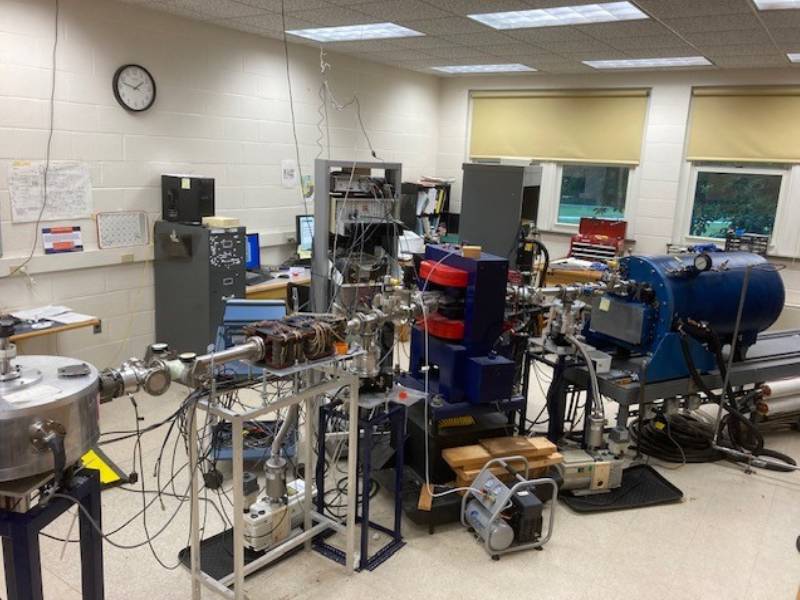Student Proton Accelerator laboratory at Gettysburg College
The Student Proton Accelerator laboratory at Gettysburg College has been built and maintained by students (see below) and faculty (Bret Crawford and Sharon Stephenson) to provide rich hands-on research experiences using techniques from nuclear physics. The 1960s era Van de Graaff PN250 High Voltage Engineering proton accelerator was acquired from Duke University in 1998 after it languished for a decade or more in a forgotten corner of the Duke Lemur Center. The accelerator was originally designed for use as a pulsed proton beam incident on a tritium foil to produce a pulsed neutron beam. The pulser and tritium foils are no longer part of the accelerator resulting in a continuous proton beam of variable energy between about 40keV and 210 keV.

In 1999-2000 student Jose Arjol-Acebal ’03 rewired and checked out all of the electronics in preparation for installing the accelerator. After decades of not being used, we successfully struck the RF ion source in 2001. Subsequent students built the rest of the vacuum beamline, refurbished a dipole analyzer magnet donated by the University of North Carolina, and equipped the target chamber with charged-particle detectors and associated electronics and software.

In addition to the above installation work and routine accelerator maintenance, student projects have included:
- Testing the relationship between the analyzing magnet’s magnetic field strength with detected beam energy,
- studying the energy dependence of the Rutherford cross section,
- proof-of-principle Rutherford Backscattering,
- studying proton damage of PDMS a common satellite coating which is exposed to and damaged by ~100-keV solar protons in while in low-Earth orbits
- Development of an Arduino and then Labwindows-CVI interface to home-built electronics to provide feedback control of the accelerator’s Dome voltage. Feedback uses both column current and left-right slits downstream from the analyzing magnet
- measurement of the 163-keV resonance in the cross section
- study of proton energy loss through thin films and benchmarking of widely-used ion energy loss simulation, SRIM
In addition to the accelerator and its associated vacuum systems (Edwards EXT255 hybrid turbo pumps) and detection electronics (PIPS detector, NIM modules, MCA), the laboratory has a thermal evaporator and a UV-VIS for optical transmission measurements. In the Gettysburg College Imaging Laboratory, students have access to a Bruker Atomic Force Microscope and a Filmetrics Profilm3D optical profiler to study surfaces at the nanometer scale.
Students who have worked in the lab:
2025
Andrews Agyemang-Duah ‘27
Isaiah Lares ‘26
Ryan Tansky ‘27
2024
Jude Belas ‘25
Emmanuel Dzuazah ‘26
Ethan Foote ‘25
Ethan Lavalley ‘25
Deepanjali Wazir ‘26
2023
Adib Kabir ‘26
Tam Nguyen ‘24
2022
Daniel Tate ‘23
Brett Travis ‘23
2020
Ezequiel Linares ‘21
2018
Ryan Gonzalez ‘19
2017
Zach Dobos ‘18
Brian Finger ‘18
Lawson Gillespie ‘18
Sabrina Marell ‘18
Rafael Marquez ‘18
Will Morris ‘18
2016
Tyler Billings ‘17
Madison LaCroce ‘17
Tanner Kirkpatrick ‘17
Alex Grun ‘17
Paul McDonnel ‘17
Dylan Mosquera ‘17
Justin Myers ‘17
Elliot Snider ‘17
Sam Wilensky ‘17
2015
Michael Booz ‘16
Zack Jaouni ‘16
Kyle Labowski ‘16
Will Vanderpoel ‘16
2014
Alana Allen ‘16
Ben Machtinger ‘15
Alex Hisey ‘15
Alex Indelicato ‘15
Stephen Pondo- Voigt ‘15
Allen VanNoppen ‘15
2010
Matt Murray ‘11
Andrew Broeker
2005
Jeff Morgan ‘06
Matt Recore ‘06
Tanya Ostapenko ‘06
2004
Zalalem Arega ‘08
Aaron Zovko ‘06
2003
Jose Arjol-Acebal ‘03
2002
Corry Dallas ‘03
Marc Morris ‘03
Jose Arjol-Acebal ‘03
2001
Jose Arjol-Acebal
Corry Dallas
Marc Morris
2000
Julia Lynch
Student Senior Capstones
``Nuclear Fusion: Measurements of the Boron-Proton Cross Section'', Jude Belas, Gettysburg College (2024).
``Alpha Particle Cross Section of Proton-Boron 11 Reaction in 50-200KeV Range'', Ethan Lavalley, Gettysburg College (2024).
``Measuring the Differential Cross Section of Boron-11 from 145-175 keV'', Ethan Foote, Gettysburg College (2024).
``Measurement of proton’s energy loss through gold thin film'', Tam Nguyen, Gettysburg College (2023).
``Creating and Measuring Nanoscopic Gold Films: A Part of Research into Proton Energy Loss Through Gold'', Daniel Tate, Gettysburg College (2022).
``Proton Stopping Power Through Thin Fims: Exploring the Neutron Lifetime with Proton Energy Loss'', Brett Travis, Gettysburg College (2022).
``Gettysburg College Proton Accelerator”, Ezequiel Linares, Gettysburg College (2020).
``Van de Graaff Voltage Regulation via PID Control'', Ryan Gonzalez, Gettysburg College (2018).
``Energy Calibrations, Thin Targets, and Rutherford Scattering Experiments with the Gettysburg College Proton Accelerator'', Matthew Murray, Gettysburg College (2010).
``Electronic Feedback Circuit for Stabilization of Gettysburg College Proton Accelerator Beam Energy'', Jeff Morgan, Gettysburg College (2006).
``The Gettysburg 250-keV proton Accelerator: Lab Updates, Calibrations, and Rutherford Scattering'', Matthew Recore, Gettysburg College (2006).
Student Conference Presentations
``Proton Energy Loss through Thin Gold Films”, Deepanjali Wazir, Bret Crawford, Bulletin of the American Physical Society (2024) BAPS.2024.G00.00023.
``Improving the 250k-eV proton accelerator to measure proton energy loss through thin films”, Emmanuel Dzuazah, Bret Crawford, 2024 National Society of Black Physicists and National Society of Hispanic Physicists Joint Conference} November 2024, Houston TX.
``Measuring Proton Energy Loss through Gold Films”, Daniel Tate, Brett Travis, Bret Crawford, Bulletin of the American Physical Society (2022) BAPS.2022.HA00100.
``Gettysburg College Proton Accelerator”, Ezequiel Linares, Bret Crawford, Bulletin of the American Physical Society 65 No. 12 (2020) BAPS.2020.GA00014.
``Van de Graaff Voltage Regulation via PID Control'', Ryan Gonzalez, Bulletin of the American Physical Society (2018) BAPS.2018.HA.00084.